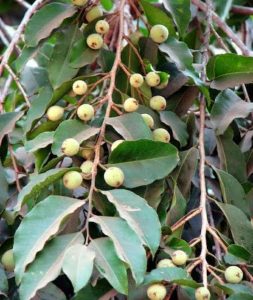BOTANICAL NAME: Putranjiva roxburghii
FAMILY: Euphorbiaceae
CLASSICAL CLASSIFICATION:
BHAVPRAKASH- Vatadi Varga
SANSKRIT NAME:
Garbhakara, Garbhada, Putranjivaka, Sutajeevaka, YashtiPushpa, ArthaSadhaka,
Kuta, Pavitra, Mantrartha Siddhikrut.
ENGLISH NAME: Child life tree, Indian amulet plant
COMMON NAME:
Hindi name – Jiyapeeta, Putranjeev


REFERENCE: BHAVAPRAKASH SAMHITA with link e Nighantu:
https://niimh.nic.in/ebooks/e-Nighantu/bhavaprakashanighantu/?mod=read
पुत्रजीव (वटादि वर्ग)
पुत्रजीवो गर्भकरो यष्टीपुष्पोऽर्थसाधकः |
पुत्रजीवो गुरुर्वृष्यो गर्भदः श्लेष्मवातहृत् |
सृष्टमूत्रमलो रूक्षो हिमः स्वादुः पटुः कटुः ||३३||
HABITAT: Found in India at 3000 feet above the sea level.
BOTANICAL DESCRIPTION: Trees, to 20 m high, bark dark grey, whitish when young with horizontal lenticels; branches generally pendent; branchlets terete, brown or blackish, slender, pubescent. Leaves simple, alternate; stipule small, lateral, caducous; petiole 5-7 mm long, slender, pubescent; lamina 3.5-12 x 1.5-4.5 cm, elliptic-oblong, base oblique, apex shortly acuminate, acute or obtuse with retuse tip; margin serrate or serrulate, glabrous, dark green, shining, coriaceous; lateral nerves 8-12 pairs, pinnate, slender, ascending, prominent, intercostae reticulate, slender, prominent. Flowers unisexual, small, yellow; male flowers: sessile, in axillary spikes, 2-2.5 mm across; pedicels 1.5-2 mm long, glabrous; tepals 3-5, oblong, puberulous without, ciliate, obtuse, imbricate; stamens 2-4, 1.5-2 mm long; filaments thick, more or less connate towards base; anthers ovate, hairy; female flowers: solitary or in 2 or 3, axillary; pedicel upto 15 mm long, puberulous; bracts lanceolate; tepals 5-6, 2-2.5 × 1-1.5 mm, unequal, oblong, puberulous without, ciliate, acute; ovary superior, 3 x 2.5 mm, globose, tomentose, 3-celled, ovules 2 in each cell; style 3, spreading, tomentose, often connate below into dilated into broad fleshy stigma; stigma crescent-shaped, glandular. Fruit a drupe, 1.3-2 x 1.5 cm, ovoid-ellipsoid, white tomentose; seed one, crustaceous; pedicels 6-25 mm long.
| RASA | GUNA | VIRYA | VIPAKA | PRABHAVA | DOSHGHNTA |
| Madhura, katu | Guru,
Pichhil |
Sita | Madhura | Garbhakar | Vátapitta shámak |
AYURVEDIC ENERGETICS:
| TASTE | PROPERTY | POTENCY | POST DIGESTIVE EFFECT | EFFECT ACTION | DOSHA ACTION |
| Sweet, Pungent | Heavy for digestion, Sliminess | Cold | Undergoes Sweet taste after digestion | Progenative | Pacifies vitiated Vata and Pitta dosha |
MAJOR CHEMICAL CONSTITUENTS: Mannitol, saponins, glucoside, alkaloids
THERAPEUTIC USES:
- Powder of seeds is given in 01-03 gms. With Milk in male to inprove the sperm count & in females to maintain the feotus.
- Paste of Leaf is applied over the affected area with Burning Sensation.
- Fresh Juice of Putranjiva is given in 10-15 ml dosage in Elephentiasis & Paste of that leaf is applied locally.
- Cold Infusion of its leaf is given to patients suffering from Dysuria.
- Seeds of Putranjiva is applied as collyrium to treat eye disorders.
INDICATIONS:
Garbhasthápan Progenative, shalipad Elephantiasis, mutrakarichh Dysuria, shoth har Anti-Inflammatory, trishná evum dáhshámak Polydypsia & Burning Sensation.
USEFUL PART: seeds, leaves
DOSAGE:
Powder – 3 to 6 gm
Leaf juice – 10 – 20 ml
AYURVEDIC FORMULATION:
Putranjaeeva Beeja Churna
